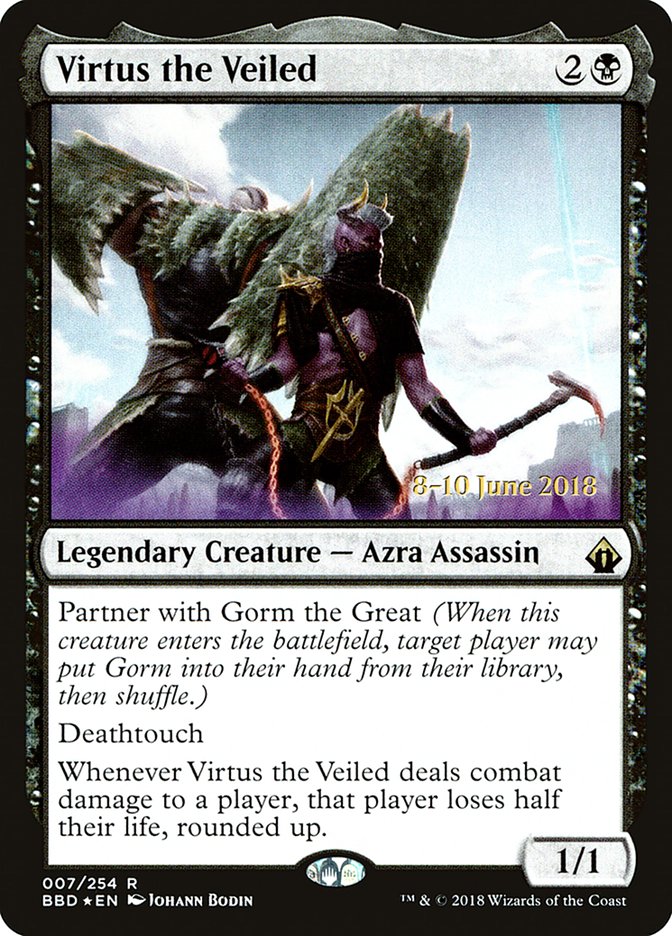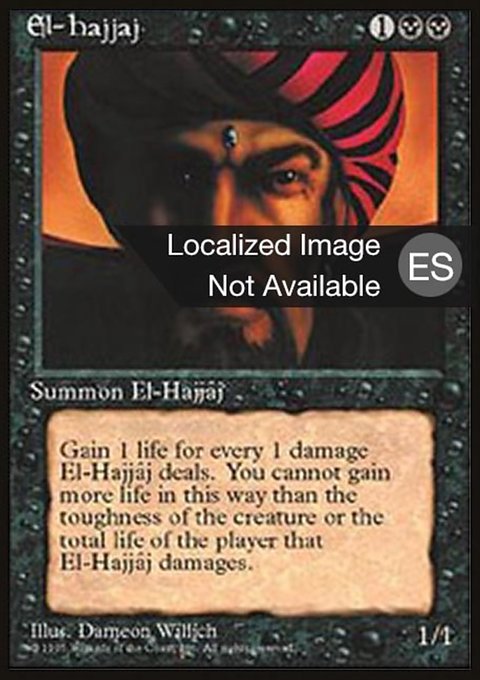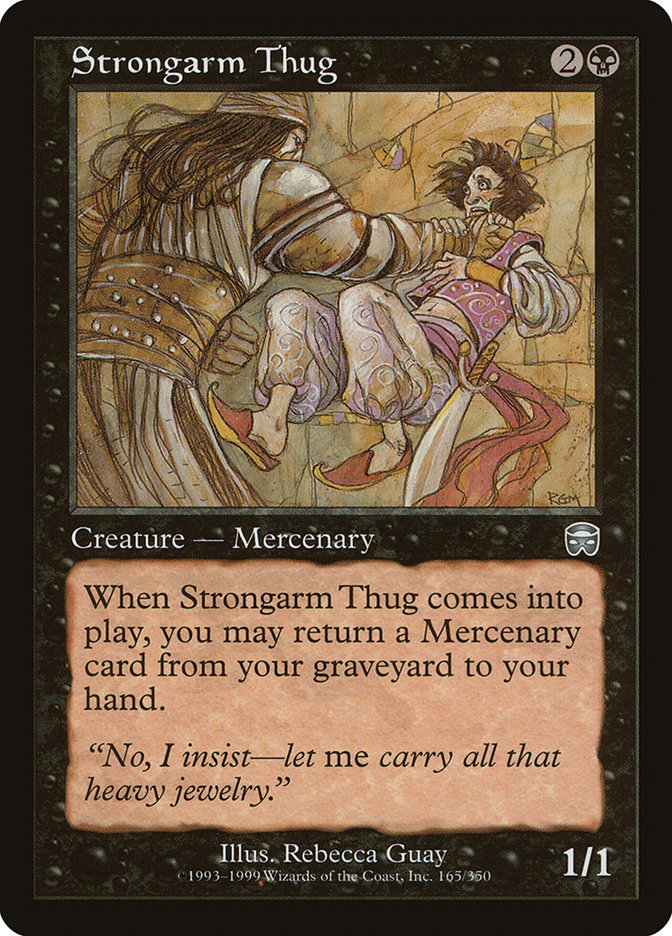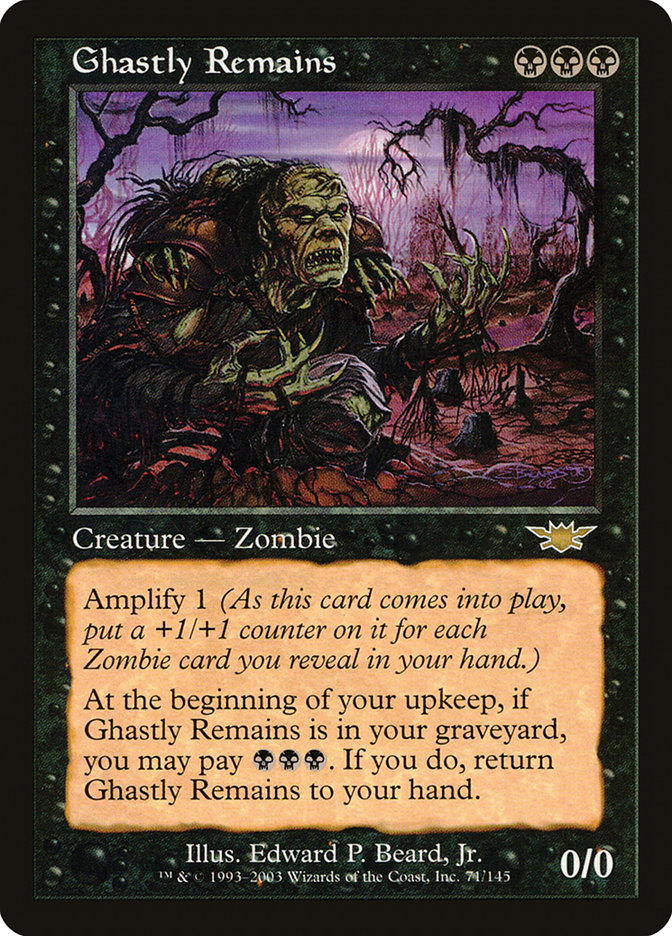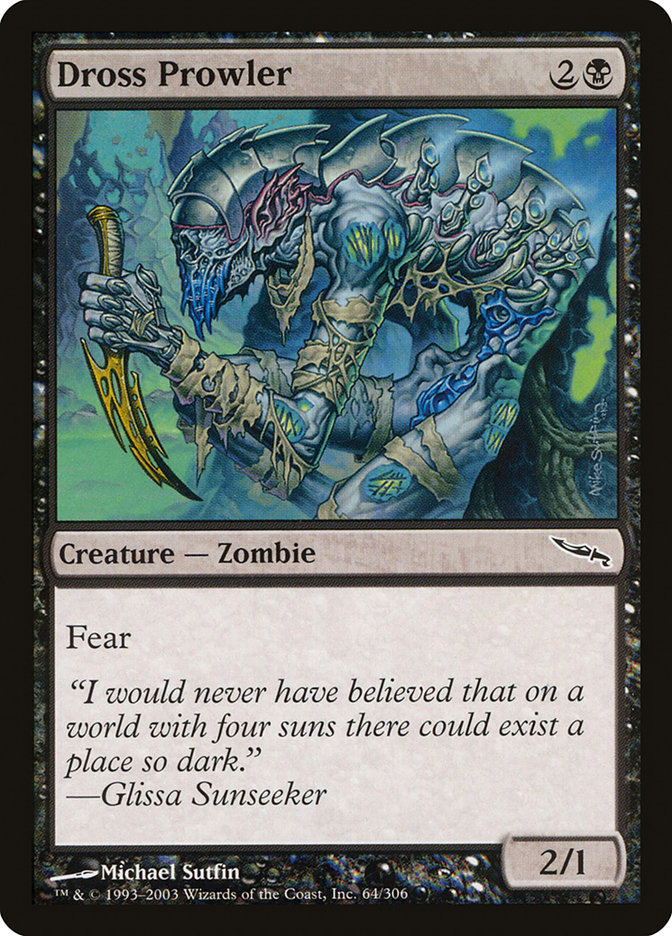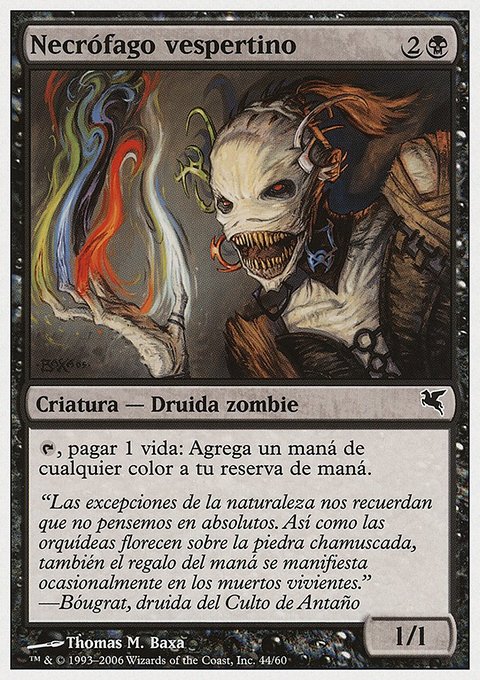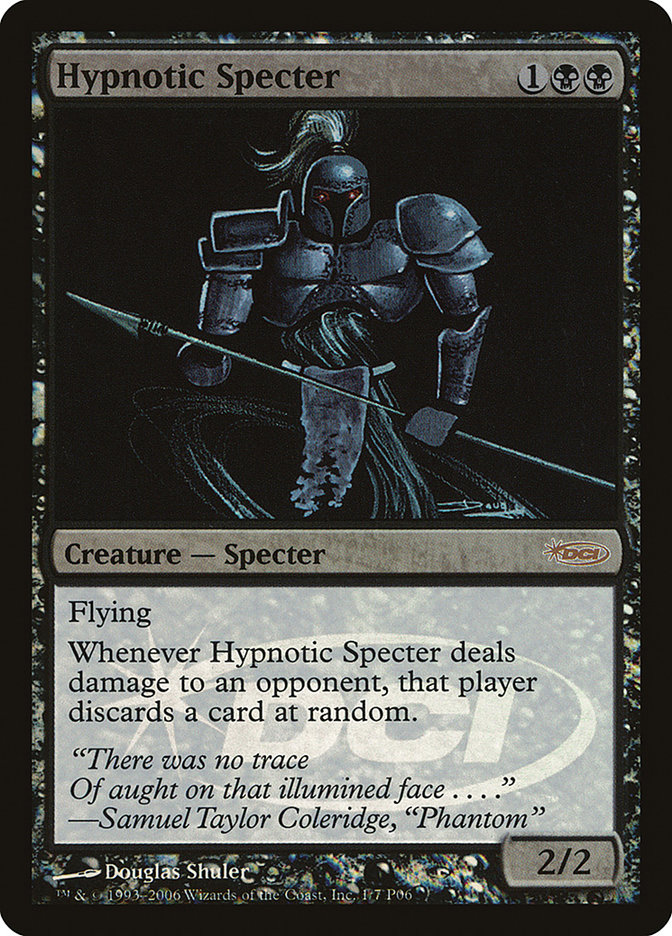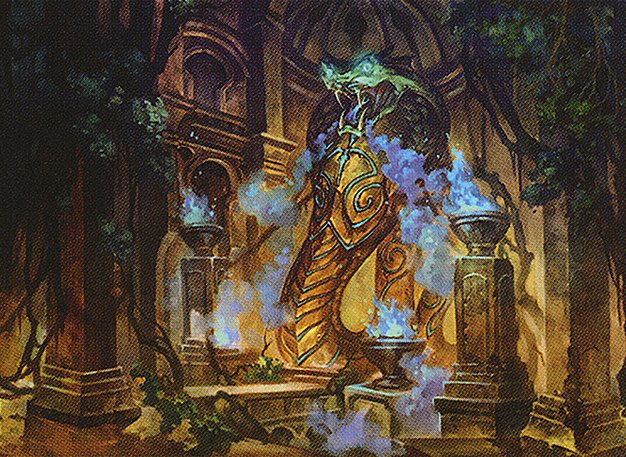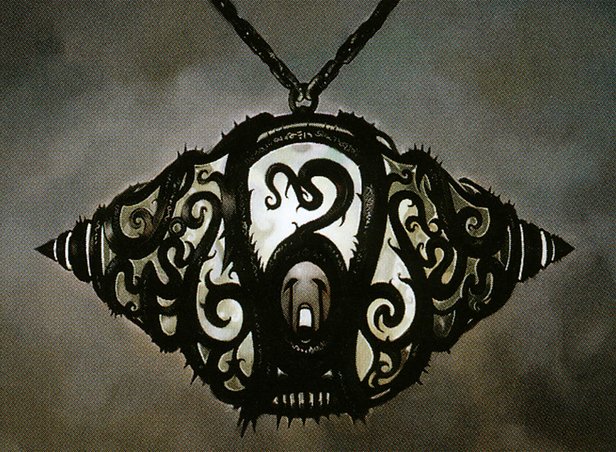Virtus the Veiled MTG Card
| Card sets | Released in 3 setsSee all |
| Mana cost | |
| Converted mana cost | 3 |
| Rarity | Rare |
| Type | Legendary Creature — Azra Assassin |
| Abilities | Deathtouch,Partner,Partner with |
| Power | 1 |
| Toughness | 1 |
Key Takeaways
- Virtus the Veiled excels in disrupting opponents and gaining card advantage through tactical creature removal.
- The demand for card discard and specific mana can limit flexibility and accelerate resource depletion.
- Its distinctive ability to halve life totals makes Virtus a worthwhile inclusion for strategic deck builders.
Text of card
Partner with Gorm the Great (When this creature enters the battlefield, target player may put Gorm into their hand from their library, then shuffle.) Deathtouch Whenever Virtus the Veiled deals combat damage to a player, that player loses half their life, rounded up.
Card Pros
Card Advantage: Virtus the Veiled enables potent tactical plays by potentially removing key creatures from an opponent’s board. This disruption often translates into a card advantage as it can force your opponent to use more resources to re-establish their board presence.
Resource Acceleration: With Virtus the Veiled, the pressure applied to your opponent can indirectly lead to resource acceleration. As opponents allocate resources to deal with Virtus, you can advance your board state with fewer interruptions.
Instant Speed: Though Virtus the Veiled itself isn’t an instant, its ability can cause instant-speed-like reactions from opponents. They may need to preemptively act during their turn to address the threat, thus giving the Virtus controller a tempo advantage and more control over the game’s pace.
Card Cons
Discard Requirement: Virtus the Veiled demands that you discard another card to utilize its full potential. While this can synergize with certain strategies, it might put you at a disadvantage by diminishing your hand, especially if you’re running low on cards or need to maintain options for reacting to your opponent’s plays.
Specific Mana Cost: Requiring a blend of both black mana and generic mana, Virtus the Veiled can be a bit restrictive in multicolored decks that might struggle with mana fixing. This specific mana cost can make it less flexible in terms of deck-building, as it necessitates a stable black mana base.
Comparatively High Mana Cost: With a casting cost that might be considered steep for its 1/1 stat line, Virtus the Veiled could be a slow starter compared to other creatures at the same cost tier. This potentially high investment can be a setback in faster-paced games where the early domination of the board is crucial.
Reasons to Include Virtus the Veiled in Your Collection
Versatility: Virtus the Veiled serves as a formidable inclusion in any black or partner-commander deck, able to apply pressure on opponents through its ability to halve a player’s life total with just one hit.
Combo Potential: Paired with cards designed to ensure its combat damage connects, such as equipment granting unblockability or evasion, Virtus can become a centerpiece in strategies seeking to rapidly diminish life totals.
Meta-Relevance: With many players leaning towards more value-oriented or creature-heavy decks, slipping Virtus into the field can upset the balance and force opponents to either address the threat or risk a speedy defeat, making it a tactical choice against certain meta trends.
How to beat
Virtus the Veiled is a cunning and elusive threat in Magic: The Gathering, prized for its potential to halve an opponent’s life total with a single strike. Tackling this shadowy assassin requires an acute awareness of board state and an arsenal of interactive spells. Preventative measures such as removal spells, like Murder or Fatal Push, can eliminate Virtus before it ever becomes a menace. Equally effective, enchantments that pacify or prevent creatures from attacking, like Pacifism or Ghostly Prison, can neutralize Virtus without having to directly remove it from the battlefield.
Of course, one must also consider instant-speed interactions. Holding up mana for counterspells, like Counterspell or Mana Leak, ensures that Virtus won’t slip through your defenses. In metas where creatures like Virtus thrive, it’s advantageous to adapt decks to include a suite of cards that can deal with such threats efficiently. As with many of MTG’s tactical layers, understanding the ebb and flow of tempo, resource management, and anticipating opponent moves will greatly improve one’s chances of defeating Virtus the Veiled and emerging victorious in the duel of wits and strategy.
BurnMana Recommendations
Unveiling the potential of Virtus the Veiled transcends just examining its pros and cons. Your MTG arsenal thrives on strategic diversity, and adding Virtus to your collection could be a game-changer, especially in black-centric or evasion-based decks. Consider the dynamic combo possibilities and the influence it has in shifting meta games. Every card, whether for its disruption capability or as part of a cunning combo, can elevate your gameplay experiences. For those intrigued by the prospect of halving an opponent’s life total with a single attack or just looking to disrupt the norm, harnessing the power of Virtus the Veiled may just be your next great strategy. Learn more and discover methods to optimize your deck with Virtus’s unique abilities for a competitive edge.
Cards like Virtus the Veiled
Virtus the Veiled stands out in the Magic: The Gathering universe, drawing comparisons to other formidable creatures that lean heavily on evasion and surprise attacks. Much like the infamous Shadowmage Infiltrator, Virtus the Veiled thrives on slipping past defenses to deal damage, yet it brings another layer of fear with its ability to halve an opponent’s life total with a single hit. Both excel in subtlety, but Virtus delivers a more devastating blow at the cost of higher vulnerability due to lower toughness.
Then there’s Quietus Spike, an equipment card that shares Virtus’s life-slicing ability. When equipped to any creature, it poses a constant threat similar to Virtus, however, it lacks Virtus’s stealthy approach and evasiveness. While Quietus Spike requires additional mana investment to equip and doesn’t itself engage in combat, Virtus is ready to attack immediately. Lastly, the comparison to Skithiryx, the Blight Dragon is inevitable. Skithiryx combines evasiveness with life-total reduction through infect counters rather than direct life halving. This dragon requires a larger mana investment but carries the potential for more predictable damage accumulation.
In assessing their strategic uses and combat impact, Virtus the Veiled has etched its unique place among MTG’s subtle yet brutally effective attackers, appealing to players who enjoy crippling their opponents with surprise offensive maneuvers.
Cards similar to Virtus the Veiled by color, type and mana cost
Where to buy
If you're looking to purchase Virtus the Veiled MTG card by a specific set like Battlebond Promos and Battlebond, there are several reliable options to consider. One of the primary sources is your local game store, where you can often find booster packs, individual cards, and preconstructed decks from current and some past sets. They often offer the added benefit of a community where you can trade with other players.
For a broader inventory, particularly of older sets, online marketplaces like TCGPlayer, Card Kingdom and Card Market offer extensive selections and allow you to search for cards from specific sets. Larger e-commerce platforms like eBay and Amazon also have listings from various sellers, which can be a good place to look for sealed product and rare finds.
Additionally, Magic’s official site often has a store locator and retailer lists for finding Wizards of the Coast licensed products. Remember to check for authenticity and the condition of the cards when purchasing, especially from individual sellers on larger marketplaces.
Below is a list of some store websites where you can buy the Virtus the Veiled and other MTG cards:
- eBay
- TCG Player
- Card Kingdom
- Card Market
- Star City Games
- CoolStuffInc
- MTG Mint Card
- Hareruya
- Troll and Toad
- ABU Games
- Card Hoarder Magic Online
- MTGO Traders Magic Online
See Magic products
Printings
The Virtus the Veiled Magic the Gathering card was released in 3 different sets between 2018-06-08 and 2018-06-08. Illustrated by Johann Bodin.
| # | Release | Name | Code | Symbol | Number | Frame | Layout | Border | Artist |
|---|---|---|---|---|---|---|---|---|---|
| 1 | 2018-06-08 | Battlebond Promos | PBBD | 7s | 2015 | normal | black | Johann Bodin | |
| 2 | 2018-06-08 | Battlebond | BBD | 7 | 2015 | normal | black | Johann Bodin | |
| 3 | The List | PLST | BBD-7 | 2015 | normal | black | Johann Bodin |
Legalities
Magic the Gathering formats where Virtus the Veiled has restrictions
| Format | Legality |
|---|---|
| Commander | Legal |
| Legacy | Legal |
| Oathbreaker | Legal |
| Vintage | Legal |
| Duel | Legal |
Rules and information
The reference guide for Magic: The Gathering Virtus the Veiled card rulings provides official rulings, any errata issued, as well as a record of all the functional modifications that have occurred.
| Date | Text |
|---|---|
| 2018-06-08 | An effect that checks whether you control your commander is satisfied if you control one or both of your two commanders. |
| 2018-06-08 | Both commanders start in the command zone, and the remaining 98 cards of your deck are shuffled to become your library. |
| 2018-06-08 | If a creature can’t block Gorm for any reason (such as being tapped), then it doesn’t block. If there’s a cost associated with having it block Gorm, the player isn’t forced to pay that cost, so it doesn’t have to block in that case either. If this means that no creatures block Gorm, Gorm isn’t blocked. |
| 2018-06-08 | If only one creature can block Gorm the Great, that creature does so. |
| 2018-06-08 | If your Commander deck has two commanders, you can only include cards whose own color identities are also found in your commanders’ combined color identities. If Khorvath and Sylvia are your commanders, your deck may contain cards with red and/or white in their color identity, but not blue, black, or green. |
| 2018-06-08 | In a Two-Headed Giant game, a player’s life total is the same as their team’s life total. |
| 2018-06-08 | Note that the target player searches their library (which may be affected by effects such as that of Stranglehold) and that the card they find is revealed, even though these words aren’t included in the ability’s reminder text. |
| 2018-06-08 | Once the game begins, your two commanders are tracked separately. If you cast one, you won’t have to pay an additional the first time you cast the other. A player loses the game after having been dealt 21 damage from one of them, not from both of them combined. Command Beacon’s effect puts one into your hand from the command zone, not both. |
| 2018-06-08 | The second ability represented by the “partner with -ame]” keyword modifies the rules for deck construction in the Commander variant and has no function outside of that variant. If a legendary creature card with “partner with -ame]” is designated as your commander, the named legendary creature card can also be designated as your commander. For more information on the Commander variant, please visit Wizards.com/Commander. |
| 2018-06-08 | The triggered ability of the “partner with” keyword still triggers in a Commander game. If your other commander has somehow ended up in your library, you can find it. You can also target another player who might have that card in their library. |
| 2018-06-08 | To have two commanders, both must have the partner ability (featured in the Magic: The Gathering—Commander™ (2016 Edition) set) or corresponding “partner with” abilities as the game begins. A creature with a “partner with” ability can’t partner with any creature other than its designated partner. Losing a partner ability during the game doesn’t cause either to cease to be your commander. |
| 2018-06-08 | Virtus’s last ability triggers and resolves after combat damage is dealt. For example, if Virtus deals 1 combat damage to a player with 10 life, combat damage will reduce that player’s life total to 9. Then its ability will cause the player to lose 5 life, leaving the player at 4. |
| 2018-06-08 | “Partner with -ame]” represents two abilities. The first is a triggered ability: “When this permanent enters the battlefield, target player may search their library for a card named -ame], reveal it, put it into their hand, then shuffle their library.” |
